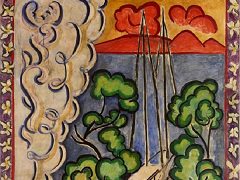Landscape with Brook, 1907 by Henri Matisse

Scenes painted from nature were of extreme importance in Matisse's early evolution, especially as he liberated himself from his earlier dark manner, first in the Breton trips of 1895-97 and then in his year spent in the south in 1898. Subsequently, in The Path in the Bois de Boulogne, he sought to assimilate certain aspects of structure of Cezanne into his then formative style. The present picture, contemporary with the great figure pieces of the period, notably Joy of Life, demonstrates how his newfound compositional design could be applied to the study of landscape.
While not yet displaying the lyrical simplicity of the later Tangier scenes, Matisse has already found a personal, unique post-Fauve vision of nature, one that supplements as well as reinforces the major tendencies of his larger, virtually mythological paintings of the period 1906-10. The surface pattern is here the chief structural device, and color is the vehicle whereby it is accomplished. The brook flows across the front of the scene, but does not lead us back into an illusionistic space. The hillside of greens, blues, and ochers offers a soft-harmony of hues that is barely disturbed by a few impetuously Fauve touches of red. Furthermore, the high horizon reinforces the picture's lack of depth, leading the eye upward rather than inward. Clearly this is a transitional painting with a few minor and undisturbing in-consistencies, as in the rather heavily painted surface of the water. However, it is an important landmark in the evolution of a motif in Matisse's art that is often overlooked. True, after the twenties, landscapes are rare in his work.



















